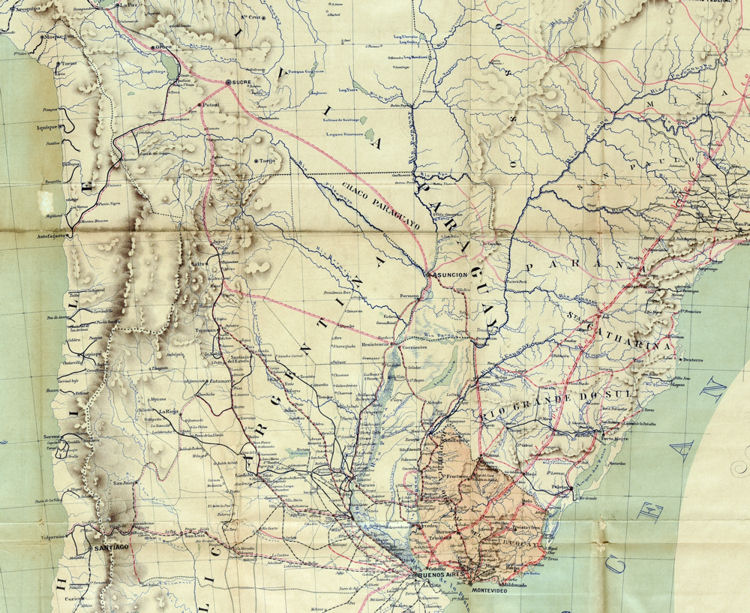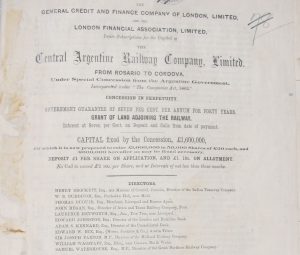The independence of South America bought an influx of opportunities for commerce and investment from Europe and North America. Everyone wanted a piece of the newly opened continent. Merchants, industrialists, and entrepreneurs arrived to make their fortunes. Welsh, Irish and Germans emigrated to make new lives in the newly opened markets and the cities. The SS Minosa1 left Liverpool in 1866 with 153 Welsh colonists destined for a new life in Patagonia. The industrial revolution saw the railways as the answer to transport goods, supplies and people quickly across the Andes and the vast expanses of this continent. Why could South America not follow European and North American railway expansion to modernise the infrastructure and open access to the remote country?

Valparaiso in Chile was the major port for South America. The natural harbour was the main deep harbour on the Pacific Coast. Valparaiso flourished as commerce and trade flowed through the port. Trade between Europe and the Pacific port went via the Cape Horn, the southernmost tip of Chile; a 3 month long, hard and hazardous journey.The ambition of an American, William Wheelwright, was to establish a line of steamers connecting the republics of Peru and Chile with Europe. The Pacific Steam Navigation Company was founded with funds raised in London. Two steam ships were bought and started between Britain and Valparaiso, Chile. The immediate problem was the supply of coal and repairs upon arriving in Chile. This was quickly resolved by the funding and building of new coaling stations.
The Chilean Government saw the advantages of steam travel and the new iron horses (as steam locomotives were referred to) from Britain, North America and across Europe. They opened up the country, allowed mass travel, and improved the economic growth of the nation. In 1842 the Chilean Government commissioned William Wheelwright to undertake a survey for the construction of a Railway.
William Wheelwright had a grand scheme to build a Trans Pacific Railway from Valparaiso to Buenos Aires. The proposed ro ute from the Pacific to the Atlantic was about 1000 miles. This could result in passengers travelling from Europe to New Zealand in [just] 47 days.
The first section to be built was the line from Valparaiso to Santiago, 110 miles. This was then extended to Tulca and Talcahuano, connecting the mines and rural areas in Northern Chile; and allowing the transport of minerals and goods for export. A network of railways was later established to transport the material from towns and mines across the Atacama Desert.
Guano
One substance found in abundance in Peru was ‘White Gold’, or Sodium Nitrate. Guano2 a natural fertilizer high in phosphates and nitrates. From 1838 Guano had been transported to Europe and England, for use by farmers. The British owned Peruvian Guano Company Ltd was founded with an exclusive contract to sell 1.9 million tons of Guano per year. The Company was involved in a number of court cases, against the Peruvian Government and also Dreyfuss Brothers and Co over finances and guano export concessions.
Over expolitation of guano during the 1800s led to the formation of the Guano Administration Company (GAO). The GAO aimed to protect the seabirds and their environment; by culling natural predators and restricting the exportation of guano. By the early 1900s the use of guano had dropped due to the production of artificial fertilizers and nitrates. The fall in Guano exports resulted in the Peru Government transferring the state railways to British owned companies to help pay off their foreign debt.
Argentine railway

The Central Argentine Company Ltd (CAR) was formed in 1863. The registered Office was at 60 Gracechurch Street; but moved to 85 Palmerston Buildings, Bishopgate Street in 18713. This British financed and owned company aimed to build a railway from Rosario (Santa Fe) to Cordova, approximately 250 miles. The cost was £6000 per mile. The concession, signed on 26 May 1863, granted 6 miles of land in breadth along the route, with the requirement for building townships and farming along the route. The company expanded the railways of Argentina, buying a number of lines including the Soceidad Anonima del Ferro Carril Oeste Santafecino [Santa Fe Western Railway Company]; which extended the line to Cruz Alto.
By the First World War Argentina, reportedly, was the tenth largest railway network in the world. The success of foreign investment in a national railway system aided the development of the economic markets. The railway opened up the interior, encouraged migration, and the exportation of goods and produce to foreign markets.
In the 1860s Charles Wood and Henry Driver designed the Central Market of Santiago [Mercado Central de Santiago]. This structure was fabricated by a Scottish firm ‘R Laidlaw & Sons’, of Glasgow. The structure was transported in sections in 1864. On arrival in Santiago Fermín Vivaceta built the new market, with a grand opening in 1872.
Other railways were built during the 1880s including the development of the Funicular railway: a cable, or cliff railway system. In the next 50 years or so, over 20 funiculars were built around Valparaiso. These systems enabled easier to the thirteen hills that make up the city.

In 1888 the Bolivian President, Aniceto Arce planned to build a railway from La Paz to the Pacific. British investors and workers travelled across the sea. Supplies for building the railway were transported duty free. The indigenous population regarded the railway as intrusive, and vandalized the line. With nothing outside Uyuni but rusting engines and wagons, and sand covered tracks disappearing into the distance, the train graveyard is now a major tourist stopover.
William Wheelwright’s ambitious plan to establish a railroad across the Andes, from Valparaiso to Buenos Aires and then to extend to Rosario, Argentina was abandoned when the difficulties of the venture were established. The cost and work of building a line across the Andes was too great. It wasn’t until 1910 that the Argentine Transandine Railway Company line opened from Mendoza, Argentina to Los Andes, Chile. This completed the line from Valparaiso to Buenos Aires, albeit using five railway companies and three changes due to the usage of different railway gauges.
Britain retained ownership of a large proportion of the Argentine railway companies until President Juan Peron nationalized the railway network in the 1948. Celebrations and parties followed throughout Buenos Aires. His aim was to modernize the railway network and infrastructure of Argentina.
Keep tabs on the past.Sign up for our email alerts.